NATIONAL POLLUTIOn pREVENTION rOUNDTABLE |
2011 MVp2 awards
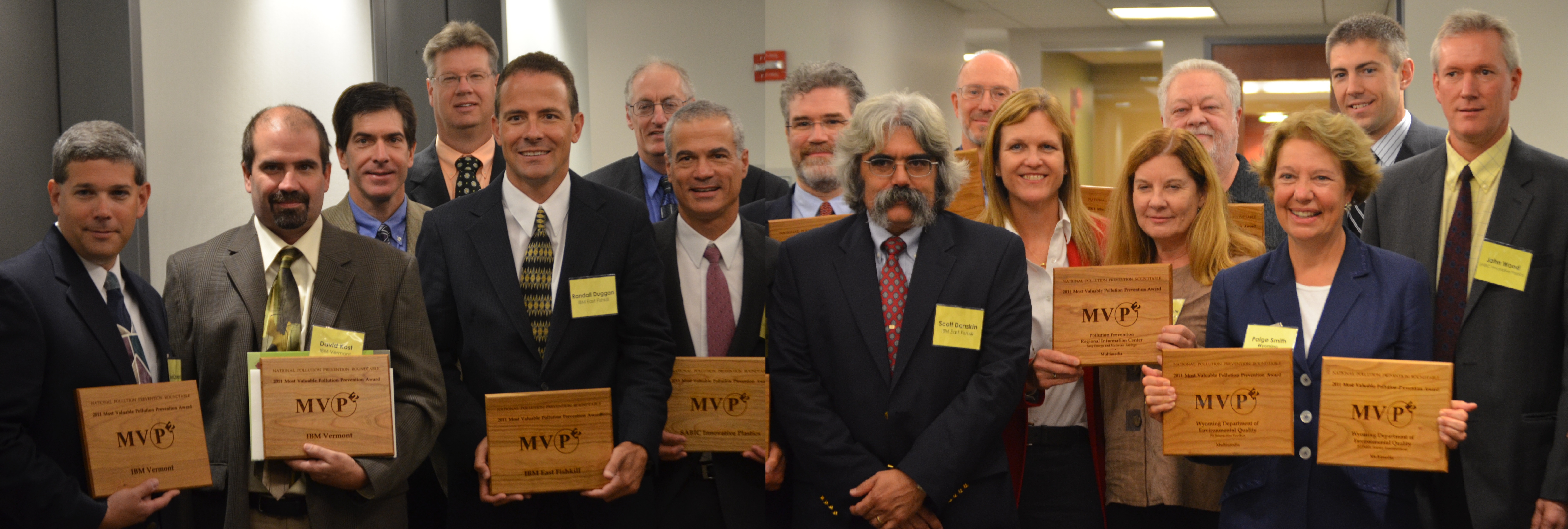
Combined the 2011 MVP2 Award winners cut greenhouse gas emissions by 800,000 tons, reduced air pollution by nearly 100,000 tons/year, conserved more than 6 billion kilowatts of energy, and reduced water consumption by over 45 million gallons/year while cutting costs by over $10 million.
P2 Project/Program Award: Cintas, Inc. (Everett, Puyallup and Yakima, WA)
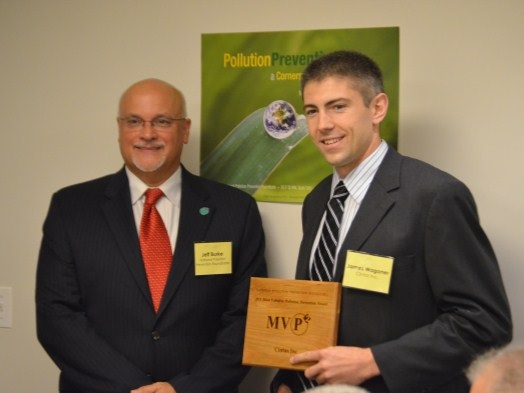 Cintas-Washington State implemented a program to eliminate 25,000 gallons of detergent that contained nonylphenol ethoxylates (NPEs) in the laundry process. In addition to using safer chemicals and inspiring others to do likewise, Cintas-Washington State facilities saved over 19 million gallons of water by developing all high efficiency washing formulas which strategically eliminate certain washing and rinsing steps, resulting in a 33% water use reduction or 240,000 gallons of water and saving $171,000 per year. The three facilities involved in this project also implemented energy conservation measures which together resulted in $60,000 in savings.
Cintas-Washington State implemented a program to eliminate 25,000 gallons of detergent that contained nonylphenol ethoxylates (NPEs) in the laundry process. In addition to using safer chemicals and inspiring others to do likewise, Cintas-Washington State facilities saved over 19 million gallons of water by developing all high efficiency washing formulas which strategically eliminate certain washing and rinsing steps, resulting in a 33% water use reduction or 240,000 gallons of water and saving $171,000 per year. The three facilities involved in this project also implemented energy conservation measures which together resulted in $60,000 in savings.
P2 Project/Program Award: IBM Vermont (Essex Junction, VT)
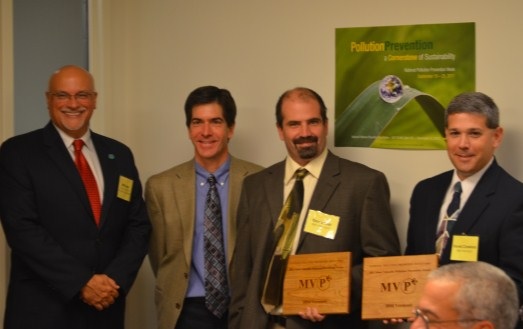 The IBM Vermont Facilities, Manufacturing, Environmental and Chemical Lab team members worked collaboratively on the design, development, and installation of a new U Tube scrubber air abatement technology. The scrubber is more reliable, cost effective, and energy efficient and results in better emissions control compared to what is commercially available today.
The IBM Vermont Facilities, Manufacturing, Environmental and Chemical Lab team members worked collaboratively on the design, development, and installation of a new U Tube scrubber air abatement technology. The scrubber is more reliable, cost effective, and energy efficient and results in better emissions control compared to what is commercially available today.
IBM Vermont's previous point of use scrubbers used filter media and recirculating pumps to provide the contact area to absorb inorganic chemistries. These scrubbers plugged frequently due to particulates in the air stream, resulting in excessive tool down time and maintenance costs. There was additional negative impact to product yields. Another problem was that the point of use scrubbers utilized a heating unit that proved to be ineffective and wasted energy. The U Tube design changes the standard approach by using water and air flow in the same direction to remove the majority of air contaminants in the first stage. The second stage (or polishing step) uses a more conventional countercurrent flow to remove even more of the remaining chemicals from the air stream prior to sending it to the central scrubber, which does the final scrubbing prior to discharge. Since this improved design is so effective in removing chlorine and hydrogen chloride gases, no additional treatment chemicals (such as caustics) are needed to adjust the pH. Furthermore, not having to introduce treatment chemicals allows the U Tube scrubber to be much more energy efficient because no pumps, actuators, and other electrically driven parts are required.
This design has resulted in significant reduction in Chlorine and Hydrogen Chloride (HCl) emissions from our semiconductor manufacturing operations. It has also reduced annual energy use by 1,110,518 kWh and has potential water savings of over 7 million gals over the conventional air abatement previously installed. The energy savings from this project equates to approximately 35 metric tons of carbon dioxide reductions annually. Total cost savings from this project are $220,000/year in energy, maintenance, and spare parts costs.
P2 Project/Program Award: IBM Vermont (Essex Junction, VT)
 IBM Vermont used Lean Manufacturing and Green Sigma techniques to identify a less than optimized nitrate removal process in their facility's wastewater treatment plant. With the help of Statistical Process Control to help manage the large amounts of wastewater data and jar tests, IBM Vermont added an anoxic (no oxygen) cycle to their treatment process with an organic waste spike (using the current sanitary influent) between the two aerobic cycles of the Sanitary Sequential Batch Reactor (SBR) treatment process. This change was fully implemented at the end of November 2009 and reduced the nitrate output by between 49% and 60% annually in the biological effluent, and subsequently by between 9% and 28% in the final industrial effluent from 2007 to 2010. Annual energy savings from this process change amount to 77,000 kilowatt hrs due to decreased blower use.
IBM Vermont used Lean Manufacturing and Green Sigma techniques to identify a less than optimized nitrate removal process in their facility's wastewater treatment plant. With the help of Statistical Process Control to help manage the large amounts of wastewater data and jar tests, IBM Vermont added an anoxic (no oxygen) cycle to their treatment process with an organic waste spike (using the current sanitary influent) between the two aerobic cycles of the Sanitary Sequential Batch Reactor (SBR) treatment process. This change was fully implemented at the end of November 2009 and reduced the nitrate output by between 49% and 60% annually in the biological effluent, and subsequently by between 9% and 28% in the final industrial effluent from 2007 to 2010. Annual energy savings from this process change amount to 77,000 kilowatt hrs due to decreased blower use.
IBM Vermont’s data management systems were an integral tool in making the above project possible. The data management systems allowed the IBM team to review, analyze and optimize the nitrates removal process in their wastewater treatment systems while ensuring that other process parameters were not adversely impacted. By implementing improved process cycles and an organic food spike, IBM demonstrated that significant improvements in water quality can be made without significant capital investment.
P2 Project/Program Award: IBM East Fishkill (East Fishkill, NY)
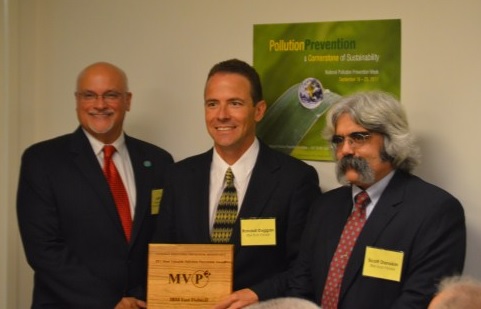 In 2003, IBM East Fishkill (EFK) initiated a Pollution Prevention (P2) Program investigation of alternative technologies to sodium bisulfite addition for reduction of hydrogen peroxide (“peroxide”) in its site waste streams. In early 2009, a catalytic enzyme process was qualified to replace the existing sodium bisulfate reduction process to remove peroxide from the wastewater. The new process uses a small quantity of enzyme to catalyze the decomposition of peroxide into water and oxygen without contributing TDS to the site final effluent discharge and at a fraction of the cost. The design of the new process incorporated existing building equipment as much as possible and was seamlessly integrated into the existing treatment system. Design and construction of the full scale peroxide treatment system was started and completed in 2009 with startup continuing through March 2010. This new treatment process eliminates use of 38% sodium bisulfate (510,000 gallons/year) and the subsequent 50% sodium hydroxide (135,000gallons/year) for acid neutralization, and reduced chemical costs by $675,000 annually while also reducing energy use and 270 tons/yr of greenhouse gas emissions.
In 2003, IBM East Fishkill (EFK) initiated a Pollution Prevention (P2) Program investigation of alternative technologies to sodium bisulfite addition for reduction of hydrogen peroxide (“peroxide”) in its site waste streams. In early 2009, a catalytic enzyme process was qualified to replace the existing sodium bisulfate reduction process to remove peroxide from the wastewater. The new process uses a small quantity of enzyme to catalyze the decomposition of peroxide into water and oxygen without contributing TDS to the site final effluent discharge and at a fraction of the cost. The design of the new process incorporated existing building equipment as much as possible and was seamlessly integrated into the existing treatment system. Design and construction of the full scale peroxide treatment system was started and completed in 2009 with startup continuing through March 2010. This new treatment process eliminates use of 38% sodium bisulfate (510,000 gallons/year) and the subsequent 50% sodium hydroxide (135,000gallons/year) for acid neutralization, and reduced chemical costs by $675,000 annually while also reducing energy use and 270 tons/yr of greenhouse gas emissions.
P2 Project/Program Award: Kentucky Pollution Prevention Center (KPPC) (Louisville, KY)
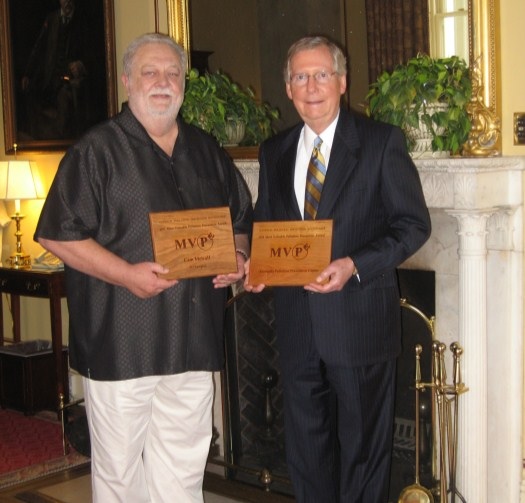 KPPC is a state-mandated, free, confidential, and non-regulatory environmental technical assistance resource center designed to help Kentucky’s businesses, industries, school districts and other organizations stay environmentally sustainable in a competitive global market. Through its Environmental Sustainability (ES) program and its Kentucky Energy Efficiency Program for Schools (KEEPS), KPPC offers on-site assessments, training, technology demonstrations, assistance with identifying project implementation resources, recognition of achievements, and web-based online resources. These resources help participants develop a systems approach to Pollution Prevention (P2) and Energy Efficiency (E2) efforts, which are the focus of KPPC’s environmental sustainability programs. KPPC provided extensive on-site assessments, training and technical assistance in 2010 and substantial reductions in waste and toxicity were identified for KPPC clients. Also in 2010, the KEEPS program achieved 100% school district participation with all 174 districts having established school board approved energy policies.
KPPC is a state-mandated, free, confidential, and non-regulatory environmental technical assistance resource center designed to help Kentucky’s businesses, industries, school districts and other organizations stay environmentally sustainable in a competitive global market. Through its Environmental Sustainability (ES) program and its Kentucky Energy Efficiency Program for Schools (KEEPS), KPPC offers on-site assessments, training, technology demonstrations, assistance with identifying project implementation resources, recognition of achievements, and web-based online resources. These resources help participants develop a systems approach to Pollution Prevention (P2) and Energy Efficiency (E2) efforts, which are the focus of KPPC’s environmental sustainability programs. KPPC provided extensive on-site assessments, training and technical assistance in 2010 and substantial reductions in waste and toxicity were identified for KPPC clients. Also in 2010, the KEEPS program achieved 100% school district participation with all 174 districts having established school board approved energy policies.
P2 Project/Program Award: SABIC Innovative Plastics (Mount Vernon, IN)
 The SABIC Mt. Vernon, Indiana engineering thermoplastic manufacturing site has converted its approximately 2.5 million gallon/year sodium nitrite-containing non-hazardous wastewater stream to a product, generating $100,000 in net revenue annually. In 2008, SABIC, together with Calgon Carbon Corporation, successfully piloted a purification process at Chem Group in Evansville, Indiana to remove the organic contaminants from the waste stream through carbon treatment. After an extensive internal environmental, health and safety review, SABIC began converting and selling 30% of the sodium nitrite wastewater stream. In March 2011, a SABIC-designed $2.5 million dollar system to harvest all the sodium nitrite from the operation was completed. The new system produces in excess of 6 million pounds per year (dry weight) sodium nitrite for their customers, and eliminates waste and the need to incinerate that waste. All the former waste material is carbon-purified at a zero-water discharge site in Evansville, Indiana near the SABIC facility. The amount of sodium nitrite recovered and sold is approximately 10% of the United States annual sodium nitrite consumption.
The SABIC Mt. Vernon, Indiana engineering thermoplastic manufacturing site has converted its approximately 2.5 million gallon/year sodium nitrite-containing non-hazardous wastewater stream to a product, generating $100,000 in net revenue annually. In 2008, SABIC, together with Calgon Carbon Corporation, successfully piloted a purification process at Chem Group in Evansville, Indiana to remove the organic contaminants from the waste stream through carbon treatment. After an extensive internal environmental, health and safety review, SABIC began converting and selling 30% of the sodium nitrite wastewater stream. In March 2011, a SABIC-designed $2.5 million dollar system to harvest all the sodium nitrite from the operation was completed. The new system produces in excess of 6 million pounds per year (dry weight) sodium nitrite for their customers, and eliminates waste and the need to incinerate that waste. All the former waste material is carbon-purified at a zero-water discharge site in Evansville, Indiana near the SABIC facility. The amount of sodium nitrite recovered and sold is approximately 10% of the United States annual sodium nitrite consumption.
P2 Multimedia Award: Pollution Prevention Regional Information Center (P2RIC) (Omaha, NE)
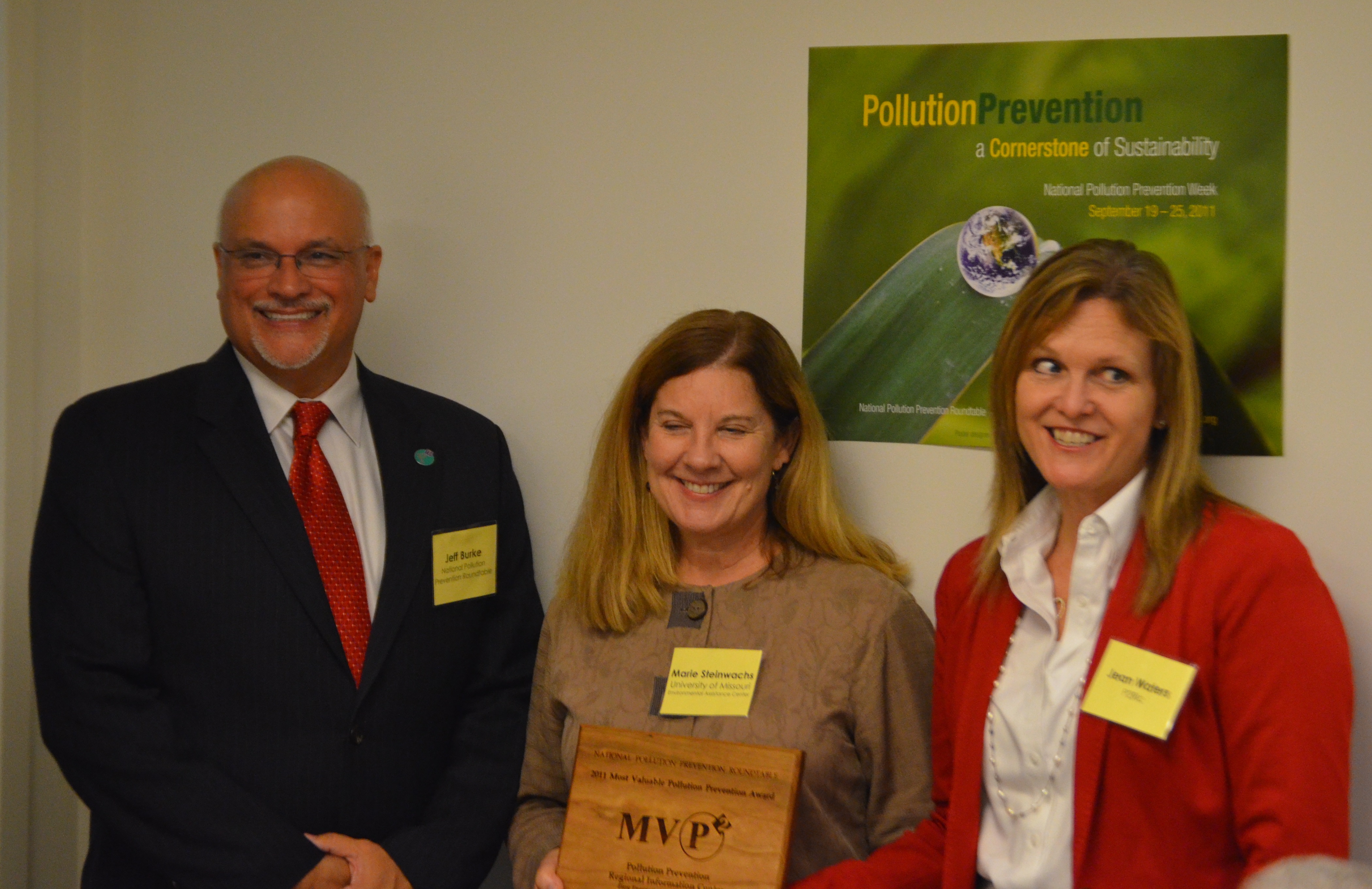 The “Easy Energy and Material Savings” booklet is a selection of case studies, mostly from P2 interns, that highlights the technology used, the money saved, and the materials saved through the implementation of P2 strategies in businesses. It is targeted toward businesses in Region 7 to inform them that their peers are undertaking relatively easy P2 projects to save materials, energy, and money and to encourage them to do likewise. Along with case studies; life cycle analysis, pollution prevention (waste management hierarchy), and other P2 educational content are highlighted in the booklet. The booklet is graphically appealing and the environmental impact of printing is quantified. Printing a low-environmental impact publication sets an example for the businesses towards which this outreach is directed. https://iwrc.uni.edu/sites/default/files/EasyEnergyandMaterialSavings.pdf
The “Easy Energy and Material Savings” booklet is a selection of case studies, mostly from P2 interns, that highlights the technology used, the money saved, and the materials saved through the implementation of P2 strategies in businesses. It is targeted toward businesses in Region 7 to inform them that their peers are undertaking relatively easy P2 projects to save materials, energy, and money and to encourage them to do likewise. Along with case studies; life cycle analysis, pollution prevention (waste management hierarchy), and other P2 educational content are highlighted in the booklet. The booklet is graphically appealing and the environmental impact of printing is quantified. Printing a low-environmental impact publication sets an example for the businesses towards which this outreach is directed. https://iwrc.uni.edu/sites/default/files/EasyEnergyandMaterialSavings.pdf
P2 Multimedia Award: Wyoming Department of Environmental Quality (Cheyenne, WY)
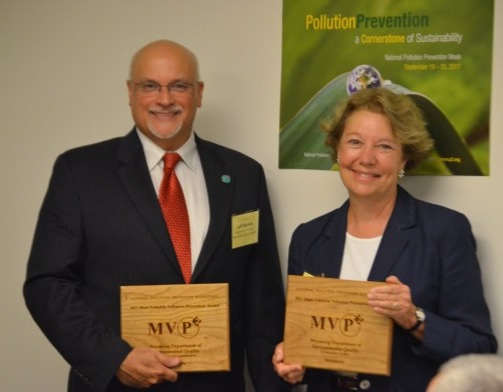 The “P2 Interactive Toolbox” is an interactive tool available to all residents of Wyoming via the WDEQ website. The outreach materials were developed for WDEQ by Tetra Tech to meet the objective of a widespread outreach campaign to educate and inform Wyoming businesses and facility owners and operators that a new Rule was adopted in 2010 and took effect in 2011 and that this Rule can have far reaching impacts. The new Rule requires entities to implement an appropriate Pollution Prevention Plan to remain eligible to participate in Wyoming’s Voluntary Remediation Program. The Interactive Toolbox supplies information, Best Management Practices, case studies, link and references that concerned parties can access in order help them implement an appropriate P2 Plan at their business. The Toolbox is easy to access and navigate, has great information, and is visually appealing.
The “P2 Interactive Toolbox” is an interactive tool available to all residents of Wyoming via the WDEQ website. The outreach materials were developed for WDEQ by Tetra Tech to meet the objective of a widespread outreach campaign to educate and inform Wyoming businesses and facility owners and operators that a new Rule was adopted in 2010 and took effect in 2011 and that this Rule can have far reaching impacts. The new Rule requires entities to implement an appropriate Pollution Prevention Plan to remain eligible to participate in Wyoming’s Voluntary Remediation Program. The Interactive Toolbox supplies information, Best Management Practices, case studies, link and references that concerned parties can access in order help them implement an appropriate P2 Plan at their business. The Toolbox is easy to access and navigate, has great information, and is visually appealing.
P2 Multimedia Award: Wyoming Department of Environmental Quality (WDEQ) (Cheyenne, WY)
 The Wyoming Department of Environmental Quality created Public Service Announcements, in the form of television ads, which were distributed to local as well as cable outlets throughout Wyoming in an effort to inform Wyoming citizens about Pollution Prevention Planning and the benefits of the Voluntary Remediation Program (VRP). Responses were very positive, and phone calls, website hits, and applications to the VRP increased after the Public Service Announcements were aired in the months of January, February, and March 2011. https://deq.wyoming.gov/shwd/voluntary-remediation-program/pollution-prevention/
The Wyoming Department of Environmental Quality created Public Service Announcements, in the form of television ads, which were distributed to local as well as cable outlets throughout Wyoming in an effort to inform Wyoming citizens about Pollution Prevention Planning and the benefits of the Voluntary Remediation Program (VRP). Responses were very positive, and phone calls, website hits, and applications to the VRP increased after the Public Service Announcements were aired in the months of January, February, and March 2011. https://deq.wyoming.gov/shwd/voluntary-remediation-program/pollution-prevention/
P2 Champion Award: Cam Metcalf
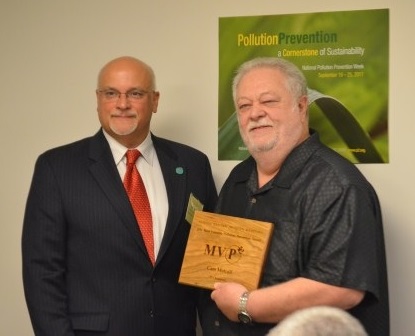 Cam Metcalf is a national leader in pollution prevention (P2) and energy efficiency (E2) technical assistance, training, and applied research with a career that spans nearly 30 years. Mr. Metcalf's experience in P2 evolution and sustainability includes tenures served on the Boards of Directors for: the National Pollution Prevention Roundtable, the Kentuckiana Chapter of Hazardous Materials Managers (KCHMM), the Louisville Advanced Technology Council, and the Kentucky International Environmental Trade Initiative. As Executive Director of KPPC, Mr. Metcalf is responsible for the continued growth of KPPC and is involved in the following activities: developing, delivering, and evaluating training programs for industries, businesses, government agencies and other organizations; directing on-site P2 and E2 assessments performed by staff engineers, engineering students and retired engineers; and directing applied research performed by staff, faculty, and students on problem waste streams. He currently serves on the Board of Directors for the Conn Center for Renewable Energy Research and Environmental Stewardship, and on the Drought Mitigation and Response Advisory Council. He is also a member of the University of Louisville Sustainability Council.
Cam Metcalf is a national leader in pollution prevention (P2) and energy efficiency (E2) technical assistance, training, and applied research with a career that spans nearly 30 years. Mr. Metcalf's experience in P2 evolution and sustainability includes tenures served on the Boards of Directors for: the National Pollution Prevention Roundtable, the Kentuckiana Chapter of Hazardous Materials Managers (KCHMM), the Louisville Advanced Technology Council, and the Kentucky International Environmental Trade Initiative. As Executive Director of KPPC, Mr. Metcalf is responsible for the continued growth of KPPC and is involved in the following activities: developing, delivering, and evaluating training programs for industries, businesses, government agencies and other organizations; directing on-site P2 and E2 assessments performed by staff engineers, engineering students and retired engineers; and directing applied research performed by staff, faculty, and students on problem waste streams. He currently serves on the Board of Directors for the Conn Center for Renewable Energy Research and Environmental Stewardship, and on the Drought Mitigation and Response Advisory Council. He is also a member of the University of Louisville Sustainability Council.
P2 Champion Award: Warren Weaver
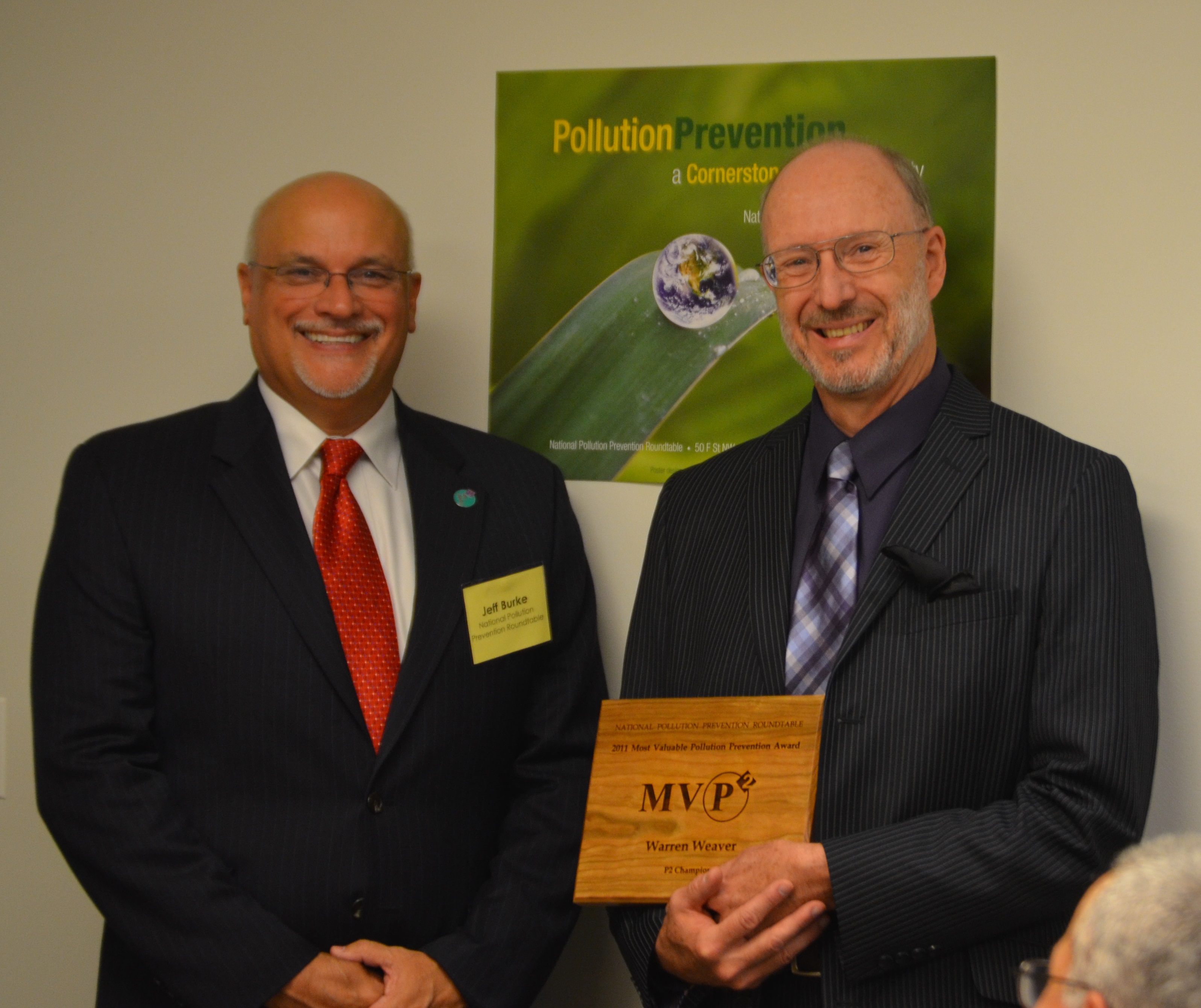 Warren Weaver has worked in the pollution prevention and environmental sustainability arena for 17+ years at PennTAP, a multi-faceted program that does broad technical assistance as an economic development function in Pennsylvania. Weaver has worked with more than 1200 clients, some on multiple projects. Clients have reported more than $80 million dollars of economic benefits as a result of his services, $3 million of which was reported earlier this year for the advantages achieved by an aircraft components’ manufacturer that implemented a number of his recommendations following a P2/E2 assessment. In addition to pollution prevention and energy efficiency assessments, he has has also performed the environmental sustainability portion of 6 EPA /NIST MEP Green Supplier Network projects. Weaver has been an NPPR member and PennTAP’s representative to its functions for nearly 15 years. Over the last 3 years, Weaver has been co-chair of the Research, Technology, and Energy Work Group.
Warren Weaver has worked in the pollution prevention and environmental sustainability arena for 17+ years at PennTAP, a multi-faceted program that does broad technical assistance as an economic development function in Pennsylvania. Weaver has worked with more than 1200 clients, some on multiple projects. Clients have reported more than $80 million dollars of economic benefits as a result of his services, $3 million of which was reported earlier this year for the advantages achieved by an aircraft components’ manufacturer that implemented a number of his recommendations following a P2/E2 assessment. In addition to pollution prevention and energy efficiency assessments, he has has also performed the environmental sustainability portion of 6 EPA /NIST MEP Green Supplier Network projects. Weaver has been an NPPR member and PennTAP’s representative to its functions for nearly 15 years. Over the last 3 years, Weaver has been co-chair of the Research, Technology, and Energy Work Group.
P2 Volunteer of the Year: Gary Hunt
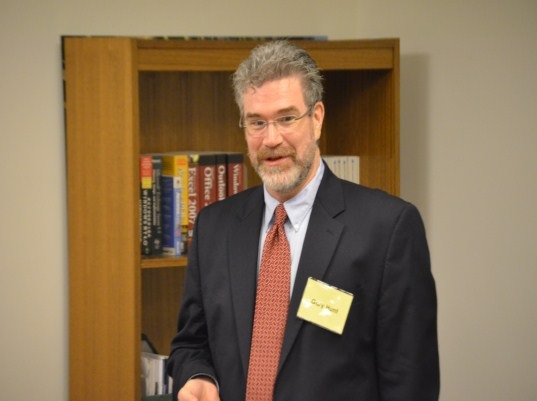 Gary Hunt was a charter member of NPPR and has served as the NPPR Board of Directors Vice-Chair and Board Liaison to the National Environmental Sustainability Summit (NESS) Planning Committee. He was also P2Rx Center Director for the Environmental Sustainability Resource Center (ESRC) that served Regions 3 and 4. Gary is retired from the North Carolina Department of Environment and Natural Resources, and over the past 25 years he as provided hundreds of clients with direct technical and management assistance on pollution prevention. He has worked with international corporations, family businesses, local governments, federal facilities, and state agencies. And he has worked with a wide range of industrial sectors including electroplating, textile, food processing, furniture, and metal fabrication. Through presentations at conferences, training sessions, workshops, and classrooms, Gary has also shown thousands of people the concepts, benefits, and implementation of pollution prevention approaches.
Gary Hunt was a charter member of NPPR and has served as the NPPR Board of Directors Vice-Chair and Board Liaison to the National Environmental Sustainability Summit (NESS) Planning Committee. He was also P2Rx Center Director for the Environmental Sustainability Resource Center (ESRC) that served Regions 3 and 4. Gary is retired from the North Carolina Department of Environment and Natural Resources, and over the past 25 years he as provided hundreds of clients with direct technical and management assistance on pollution prevention. He has worked with international corporations, family businesses, local governments, federal facilities, and state agencies. And he has worked with a wide range of industrial sectors including electroplating, textile, food processing, furniture, and metal fabrication. Through presentations at conferences, training sessions, workshops, and classrooms, Gary has also shown thousands of people the concepts, benefits, and implementation of pollution prevention approaches.
